日時: 2015年8月1日[土]15:00–17:00
場所:アートスペースキムラ 2Fギャラリー
同時映像配信:NVS宇宙科学チャンネル(ニコニコ生放送)
発表者:(所属と職名は実施時の表記)
鈴木浩之[金沢美術工芸大学 准教授]
大木真人[宇宙航空研究開発機構(JAXA)地球観測研究センター 研究開発員]萩原朔美[多摩美術大学 教授]
石井瑞穂[ARCUS Project コーディネーター]
菅谷智洋[宇宙航空研究開発機構(JAXA)第一宇宙技術部門 広報]
秋庭史典[名古屋大学 准教授]
挨拶│木邑芳幸[アートスペースキムラASK? 代表]
鈴木が実施してきた人工衛星の機能を利用した作品群は5年前(2010年)からASK?で展示を行っている。毎回ステップアップしており、今回はシンポジウムが開かれるとのことで、楽しみにしている。
第1部─研究メンバーによる発表
15:00-15:15
鈴木浩之│だいちの星座 概要
人が星空に星座を描いた太古から、「地球は丸く(後に)青い」という地球観の獲得に至る現代まで、人は科学と芸術によって宇宙の中の地球、さらにはそこに住む人についての概念を拡張し続けている。既に14世紀には科学で得られた知見に基づき地球と宇宙の関係が立体的な図として芸術によって示され、または、芸術によって構想されたビジュアルを伴うストーリーが、科学によって実際の宇宙で展開された。恒常的に地球外の視点が得られる人工衛星の機能は、芸術によって利用され始めている。トム・ヴァン=サントの《リフレクションズ・フロム・アース》(1980)やピエル・コントゥの《シニャチュール・テール》(1989)と同様に《だいちの星座》も地球外の視点を利用した芸術活動であり、芸術と科学が同じフィールドであることを示す活動だ。2010年に鈴木が始めた、人工衛星を利用した地上絵制作の試みは、2013年より大木真人(JAXA)との共同研究のスタートによって「だいち2号」をベースとした新たな活動へと発展し今日に至っている。
15:15-15:30
大木真人 │だいちの星座 科学からのアプローチ
写真家であり芸術家のナダールが世界のリモートセンシング(地球観測)画像を撮影した。衛星画像と芸術は同じフィールドの同じ活動としてスタートしている。宇宙から地球を見た想像図の変遷、実際に宇宙から撮影された写真の比較によっても芸術と科学のお互いの影響が見てとれる。科学と芸術が共に協力して同じ制作活動を行った点に意義がある。科学技術の研究者にとって人工衛星を利用した芸術活動は電波という絵の具とだいち2号という筆で描く新しい手法の地上絵だと言える。芸術と科学がすべてのプロセスで協働して初めて実現する。芸術と科学が不可分なアートプロジェクトである。
第2部─研究成果、及び、社会との関わり
15:30-15:45
萩原朔美│芸術表現としてのだいちの星座
自己主張は表現ではない、表現とは自己を消す作業だと考えているが《だいちの星座》からはそれを感じ取ることができる。一般的に彫刻や映画には自画像というものがほとんどみられないが、《だいちの星座》は宇宙から自分たちを撮影するセルフポートレートと捉えることができ、同様に自画像が生み出される絵画やビデオ、スマートフォン文化へと変遷する芸術の系譜に属する〈写真〉作品と考えることができる。小説家のポール・オースターが美術作家のソフィ・カルに与えた定点観測の勧めの如く、人工衛星の目を利用して定点観測によってあぶり出される日常の中の物語の発生が表現されている。カメラを向けることによって「風景が演技」している。宇宙から大地を見下ろす視点と、大地から「星座」を見上げる視点の往復もこのプロジェクトの特徴のひとつだと考えられる。人生は芸術の後を追い、芸術が人生であると言える。
15:45-16:00
石井瑞穂│だいちの星座 地域プログラムとしての可能性
《つくば座》・《もりや座》についてアーカスプロジェクトが主催した経緯の説明を行う。アートと地域を結ぶ交流プログラムとして《だいちの星座》が実施された。元々、異分野と思われている芸術と科学を結ぶ企画を模索しており、宇宙科学分野への個人的な興味から鈴木の活動に関心を持った。通信によって人工衛星から送られてくる地球観測データという目に見え難い事象をアンテナと受信機を使って実時間上で可視化するワークショップを企画した際、後に《だいちの星座》で共同制作者となる鈴木と大木を招聘した。《たねがしま座》で実施した内容に比べ、より市民が積極的に参加する企画として実施したことは、アートと地域を結ぶ交流プログラムを基本としていたことによる影響が大きい。400名ほどの参加者それぞれが自発的に行動することで、作者らも予測ができない、パフォーミング的な要素が生まれた。世界的な展開にも十分可能性を感じる。地域交流の観点から、芸術分野の施設において宇宙科学や天文への関心が高い参加者らと芸術作品の制作を行ったことの意義は大きい。科学体験の先にある芸術鑑賞への興味の持続性に今後の課題があると感じた。
16:00-16:15
菅谷智洋│JAXAから見ただいちの星座
生活に不可欠な実用衛星とその運用について、広報によって正しい理解を得ることには多くの課題がある。《だいちの星座》は、JAXAが企画するプロモーション活動では無い(芸術活動や科学教育として実施されているアート+サイエンス・プロジェクトである)にも関わらず一般参加者らがレクチャーやワークショップ、人工衛星からの撮影を通して人工衛星の機能について経験的に知ることのできる優れた活動である。科学技術、とりわけ、宇宙科学技術の学びの入り口として今後の展開に期待している。
16:15-16:30
秋庭史典│芸術と科学の関係ついて
シドニー・ビエンナーレ(第17回, 2010年)で杉本博司が展示した作品《放電場 (Lightning Fields)》シリーズにおいて、電力の発見や発電の起源、歴史や宗教にも触れつつ未来を問い、社会との結び付きが生まれている。《だいちの星座》は、そうした〈起源〉への問いに加え、科学の先端的な問いがうまく組み合わせられた活動だと考えている。フェッラーラの壁画にも見られるように星や星座は古くから芸術表現のテーマとなっており、同じく星座をテーマとする《だいちの星座》は起源の方向への問いを備えていると同時に、先端技術を利用して制作を行なっている。「100万回やったら1回だけうまくいく、その1回性の閉じ込めがアート」と、人工生命の研究者である池上高志は述べている。《だいちの星座》は、この1回性の閉じ込めが行われたアートである。地球に生命をもたらしたとされるシアノバクテリアの研究と芸術活動を行う岩崎秀雄のように、科学者が芸術活動を行う事例が増えてきているが、そういった流れと合致している。《だいちの星座》はこれまで宇宙科学と芸術の接点で実施されてきた試みと異なり、誰でも参加できる可能性を持った活動である。起源と未来を考えることで私たちは自由になることができ、拘束を解くことができる。このように、大きなスケールで考えることができる活動を面白いと思っている。
第3部─ディスカッション
16:30-17:00
テーマ「芸術表現と人工衛星『だいちの星座プロジェクト』について」
シンポジウムを振り返って
石井 企画したプロジェクトにおいて多くのプロセスを踏むなかで市民の自発性に触れたことが強く印象に残っている。
鈴木 芸術は100万回中の1回性の閉じ込めだとすれば、科学の定義はどう例えられるか。
秋庭 科学は100万回の内、99万9,999回は同じことができなければならない。しかし、発見のプロセスは同じではないか。ひらめきや手の器用さはそれぞれの分野で大事なこと。《だいちの星座》では子どもに方法を伝えているが、その確実性が優れている。
菅谷 鈴木、大木はJAXAが広報的に関わる前から実験を重ねていた。作品や展示などを見ると時間をかけた成果がよく表れていると感じた。
鈴木 《だいちの星座》で星座の背景となった「星空」は、2011年の東日本大震災以前に地球観測衛星「だいち」から撮影された地上の観測画像と、それぞれの《だいちの星座》制作年に撮影された地上の観測画像を重ね合わせて差分解析を行っている。
萩原 この2人のプロジェクトは〈差異と反復〉だと思っている。このテーマは私と同じである。フィッシュリ・アンド・ヴァイスを想起させる。2人の作家性を消す部分に興味が残る。
大木 プロジェクトを展開していきたい。今後も人の心を動かす活動を続けていきたい。
鈴木 国外で本プロジェクトを科学教育の入り口として機能するプログラムとして実施したいとの依頼があったところだ。今後とも国内外で制作・発表を続け、多くの人に活動を知っていただけるように努めていきたい。
Artistic Expression and Artificial Satellites
August 1, 2015 (Sat.) 15:00–17:00
art space kimura ASK? 2nd floor gallery
Live stream: NVS Space Science Channel (Niconico Live)
[Speakers]
Hiroshi Suzuki (Associate Professor, Kanazawa College of Art)
Masato Ohki (Researcher, Japan Aerospace Exploration Agency [JAXA])
Sakumi Hagiwara (Professor, Tama Art University)
Mizuho Ishii (Coordinator, ARCUS Project)
Tomohiro Sugaya (PR officer, JAXA)
Fuminori Akiba (Associate Professor, Nagoya University)
Opening Remarks: Yoshiyuki Kimura (Director, art space kimura)
Suzuki’s series of works using the functions of artificial satellites has been exhibited at ASK? for the past five years, since 2010. The project has evolved with every installment, and so this symposium is an exciting prospect.
Part 1: Presentations by Research Members
15:00–15:15
Hiroshi Suzuki│Overview of Constellations of the Earth
From ancient times, when the constellations were drawn across the starry sky, to today’s world in which mankind has learned that the Earth is round and (later) blue, humanity has been continually expanding its conception of Earth within the universe – and of its inhabitants – through science and art. By the 14th century, art had already depicted the relationship between the Earth and the universe as a three-dimensional diagram, based on scientific understanding; to look at it another way, a narrative accompanied by visuals, imagined by art, was staged in the real universe by science. Artificial satellites, which constantly provide perspectives from out of Earth, are beginning to be used in art more and more. Like Tom Van Sant’s Reflections from Earth (1980) or Pierre Comte’s Signature Terre (1989), Constellations of the Earth is an artistic endeavor that uses an “extraterrestrial” perspective, which demonstrates that art and science can be one and the same field. Since 2010, Suzuki has been working on producing geoglyphs (large-scale drawings on land) using artificial satellites. In 2013, this became a joint research with Masato Ohki at JAXA, developing into a new project based on the Daichi 2, which has continued to this day.
15:15–15:30
Masato Ohki│Constellations of the Earth: a scientific approach
The photographer and artist Nadar captured the first “remote sensing” images that observed the Earth from the sky. Satellite imagery began as an artistic activity, in the same field as art. The mutual influence of art and science can be gleaned from the changes in the conceptional diagrams of the Earth as seen from space, and from comparisons of actual photographs taken from space. The key is that art and science assisted each other to collaborate in the production of this work. For researchers in science and technology, artistic practice using satellites can be said to be a new approach to geoglyphs that uses radio waves as paint, and Daichi 2 as a brush. The constellation can only be realized with art and science working together in every step. It is an art project in which art and science are indivisible.
Part 2: Research Results, and Relationship with Society
15:30–15:45
Sakumi Hagiwara│Constellations of the Earth as artistic expression
In the speaker’s opinion, expression is not self-assertion but self-negation; Constellations of the Earth is a project that reinforces this idea. As a general rule, self-portraiture is rare in sculpture or cinema. But the Constellations can be seen as self-portraits that photograph the participants themselves from space. It can also be regarded as a work of photography that belongs within the lineage of self-portraiture in art that shifted from pictorial art to video, and to the smartphone culture. Just like artist Sophie Calle’s fixed-point observation, an idea given her by novelist Paul Auster, Constellations expresses the emergence of everyday narratives that are exposed by fixed-point observation through the eyes of an artificial satellite. Pointed at by the camera, the scenery begins to act. Another feature of this project is the perspectival back-and-forth between one point-of-view that looks down upon the land, and the other that looks up at constellations. This is expression of life taking after art, of art being life itself.
15:45–16:00
Mizuho Ishii│The possibilities of Constellations of the Earth
as a local program
The speaker gave an explanation of how ARCUS Project came to host the Tsukuba and Moriya installments of the Constellations project. Constellations of the Earth was run as an interactive program that connected art and the local region. ARCUS Project has been exploring ways to connect art and science, which are generally thought to be separate fields. The speaker was drawn by Suzuki’s activity from a personal interest in the field of space science. A workshop was held on taking intangible Earth observation data communicated from artificial satellites, and visualizing it in real-time with an antenna and receiver – with Suzuki and Ohki as the guests, who later became co-creators of Constellations. Compared to the Tanegashima Constellation, this project was set up to include more active participation from the public; this was largely due to the fact that the basis of the ARCUS Project lay in interactive programs that connected art and the local region. The independent actions of close to 400 participants generated a performative aspect, which the artists themselves were unable to predict. There is also a lot of possible room for developing this project globally. This was a very valuable project from the perspective of creating connections within the region, in that it was the production of art at art-related facilities, but with participants with strong interest in space science and astronomy. The next step is to consider the sustainability of artistic interest that follows a scientific experience.
16:00–16:15
Tomohiro Sugaya│Constellations of the Earth as seen by JAXA
There are many challenges that make it difficult to promote, through PR, an accurate understanding of satellites that are indispensable for everyday life, and of how they operate. Constellations of the Earth is not a promotional activity run by JAXA but an art-cum-science project, run as an artistic activity and for science education. It is a superb initiative that allows members of the public to gain experiential learning about the functions of artificial satellites, through lectures, workshops, and imaging created by a satellite. There are high hopes for the project’s future development as an entryway to science and technology, in particular in fields related to space.
16:15–16:30
Fuminori Akiba│On the relationship between art and science
The Lightning Fields series, exhibited by Hiroshi Sugimoto at the 17th Biennale of Sydney (2010), addressed ideas such as the discovery of electricity and the origin of its generation, history, and even religion, while also asking questions about the future, and creating a connection with society. In addition to such questions about the “origin,” Constellations of the Earth is an initiative that also integrates questions related to cutting-edge science. As seen in the frescoes in Ferrara, stars and constellations have been a theme of artistic expression since ancient times. This project, which also addresses the theme of constellations, includes questions directed toward origin; however, it is also produced deploying the latest technology. Artificial life researcher Takashi Ikegami once said that “art is the crystallization of that one time out of a million tries that something turns out well.” Constellations of the Earth is art that achieves this crystallization of this “one time.” There are more and more scientists engaging in artistic practice, such as Hideo Iwasaki, who is at once artist and researcher of cyanobacteria organisms that are said to have made life on Earth possible. Constellations is also in keeping with that trend. In contrast to previous initiatives that unfolded at the junction between space science and art, anyone can potentially participate in Constellations. Thinking about our origins and our future will set us free, removing our constraints. I think this initiative, which allows people to think big, is an exciting one.
Part 3: Discussion
16:30–17:00
Theme: “Artistic Expression and Artificial Satellites:
On the Constellations of the Earth Project”
Reflections on the symposium
Ishii In going through all the many processes of this project, one factor that left a strong impression on me was that we managed to encourage the local residents’ sense of autonomy.
Suzuki If art consists in crystallizing that once-in-a-million quality, how might we define science?
Akiba Science is required to be able to produce the same result 999,999 times out of a million. But the process of discovery is surely the same. Inspiration and manual dexterity are important in both fields. Constellations of the Earth managed to teach children the methods too in a surefire way.
Sugaya Suzuki and Ohki have been experimenting since before JAXA became involved in the promotion. Looking at the artwork and the exhibits, it was easy to see the fruit of the time that they had spent.
Suzuki Difference analysis was conducted on the “starlit sky” that served as the backdrop of the “stars” in Constellations of the Earth, by comparing images captured by the Earth observation satellite Daichi, before the Tohoku earthquake in 2011, with images captured of the land in the respective years of Constellations.
Hagiwara I believe that the theme of these two artists’ project lies in “difference and repetition,” a theme that I share. It calls to mind the works of Fischli and Weiss. I am interested by its aspect of renouncing authorship.
Ohki I want to carry on developing this project, and to continue activities that move people.
Suzuki We have just received a request from overseas to use this project as an entryway for science education. I would like to continue producing and presenting it at home and abroad, and try to reach as many people as possible with its activities.


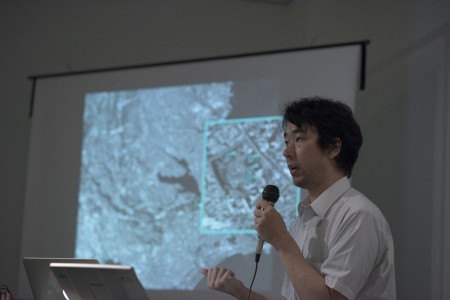
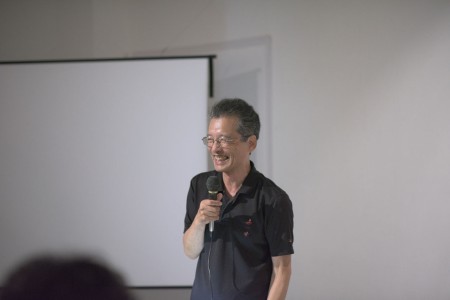

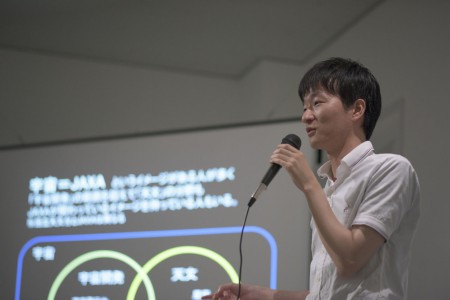
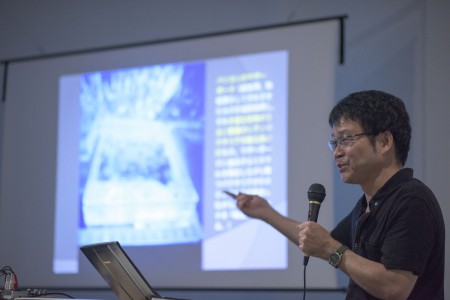
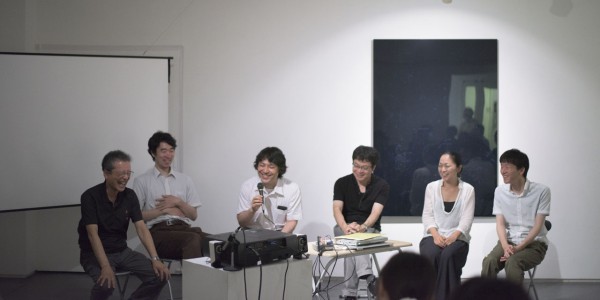
Comments are closed